Rwandans certainly have a culture of walking. They often have little other choice. Primary school pupils regularly walk two hours to come to school. What are the toughest things about being a teacher in Rwanda was a question asked in a recent educational survey. The answers one might expect would be large class sizes or poor pay but some said it was walking to school in the rain. Fair enough. This reflects the difficulty of getting about in a downpour with no protected means of transport.
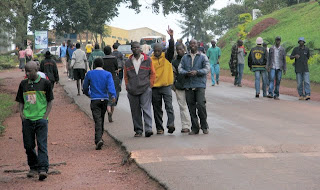 |
| Crowds of walkers |
In a hot place like my hometown of Cairns, where the car is king, people don't walk very much. Here, I have started to walk a great deal. For exercise yes, but also because everyone else is doing it so why not follow. It seems lazy and indulgent to take a moto or taxi (minibus) when others are walking. A short taxi trip from the Rompway (intersection of the road north and south) to mu muji (the Kibungo buzzing heart) costs less than 20 cents but why pay unnecessary money, most people sensibly reason, when it is only 35 minutes' brisk walk - a trifling distance. Besides think of the conversations you can have while walking with someone, the laughter you can share; or the observations you can participate in - why has that car stopped and that crowd gathered - and, of course, there is the fascination with any strange individuals from foreign lands who happen by.
 |
| A nice view over the edge while out for a walk |
Then, there are mobile phone calls to be made and received while walking and texts to be sent, miraculously done without tripping over that large paving stone right outside the eponymously named Stella Taxi Express Bureau five minutes from our house. I was walking along a street in Cairns once when the bloke in front of me phoned his girlfriend to let her know that he was walking along the street AND eating a sandwich. Must have been true love. I tried peering over his shoulder but couldn't see whether it was ham or cheese. Conversations here must be more profound because people don't eat or drink in public. By the way, my Stella predates their transport operation and has copyright on the name. I raise this because they tried to charge us for taking a picture of the sign provoking much harrumphing indignation on our part.
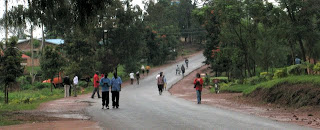 |
| Walking up towards the Rompway |
One of the school principals said he loved to walk to allow his mind to go blank. When I walk, on the other hand, I am thinking of workshops to prepare, emails to send, blogs to fix up, online banking that needs checking, articles to be read, Kinyarwanda words to learn, overseas children to worry about - and with my third eye I am on the lookout for that unusual avian sighting. Please not another Common Bulbul. Most of the above are, in some way, connected to things electronic which very few Rwandans have access to - not the birds, of course, but they usually require binoculars which are not exactly a common recreational device around these parts. The institutional, and self-inflicted, complexity of western life certainly requires massive and endless feeding. Be still busy brain. I should become a monk.
 |
| Woman carrying basket and baby |
I tend to walk with my head down later in the day when my morning chirpiness has somewhat dissipated. But in the morning when my head is higher there are plenty of things to observe that make the walking experience worthwhile. Rwandans, for example, are always well. No 'okays' or 'not bads' in the daily greetings. Even if you have limbs missing, are in a prisoner's uniform, or dressed in rags and at death's door you are always 'mesa' or 'fine'. I said 'mabi' or 'bad' one day when I was exhausted coming up a hill after a gruelling hike and was asked how I was. The questioner, a subsistence farmer who lived in a mud hut, was horrified and quickly corrected me, informing me, whether I liked it or not, that my state of wellbeing was perfect. I tried to tell him I was just kidding but my Kinyarwanda wasn't up to it and doubtless left the impression that I was an ungrateful muzungu wretch who wasn't satisfied with his lot.
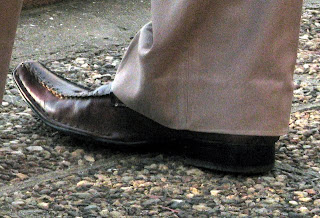 |
| Chisel toe shoes |
And yet in the office the other day two staff members were practising their English when one said that he 'wasn't so good'. There were chortles of laughter when I made him recant in Kinyarwanda but he had momentarily been given licence to be less than perfectly fine in a foreign language and that must have been a nice feeling. Rwandans certainly have many good reasons to moan but that's most likely the reason that they very seldom do.
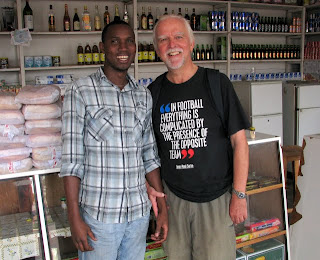 |
| With Theogeme |
If I didn't walk a lot, I wouldn't notice the things that make life so charming here. The prison guard casually texting, back turned, while prisoners smash huge stones with pick axes while upgrading the entrance to the jail. I wouldn't risk taking or publishing a picture of prisoners but the Guardian newspaper can because they're bigger than me. See my edited article at:
http://www.guardian.co.uk/world/2011/mar/15/letter-from-rwanda-prisons-walls
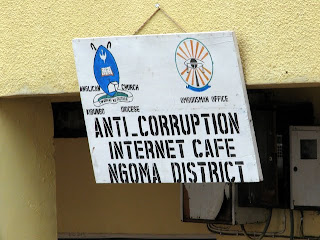 |
| The famous cafe |
Observe too, the beautiful, polished, chisel-toed shoes that many Rwandan men wear, and keep clean, on the muddiest of footpaths. Footwear is considered very important here and I brought a safe, brown pair of shoes with me that don't show up the dust so easily. Chisel toes, like winkle pickers before them, are not quite my style. Then there are the elegantly dressed women with upright posture often carrying brown paper bags of goods, baskets or even sacks of potatoes on their heads. These weighty items never look in any danger of falling off or disturbing the grace of the bearer.
 |
| The controversial poster |
A stroll helps pick out shops with funny signs like the Anti-Corruption Internet Café, with reputedly the fastest Internet service in town, where you maybe get to use the Internet for free in exchange for some 'useful information'. Rwanda has been called the least corrupt country in Africa and who am I to disagree. Often I will visit Theogeme at the petrol station shop at the Rompway, which appears to have the Quaker oats market tied up, and where I enjoy the warm greetings and fancy handshakes we exchange. Right outside, at the intersection, is one of those Sugar Daddy posters that cover the roadsides. It's part of a national campaign against men who support younger women financially usually for sex. This one is controversial. What is that woman on the right doing with the Shuga Dadi? Is she meant to be a pimp? If so, I should report her at the Anti-Corruption Internet Café in exchange for half an hour of free, fast downloads.